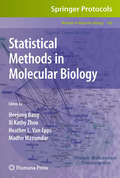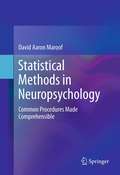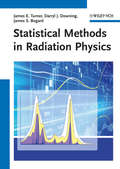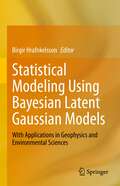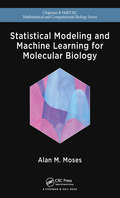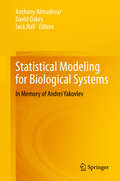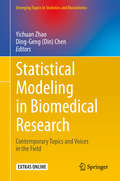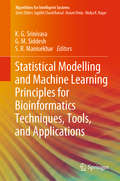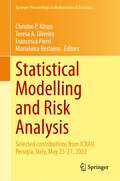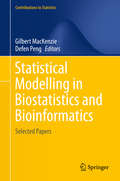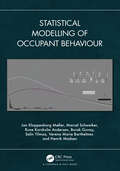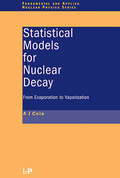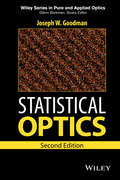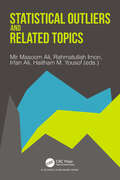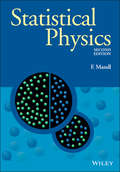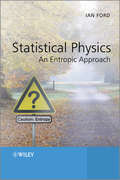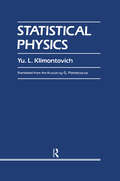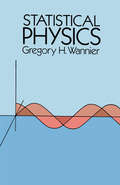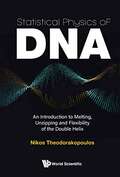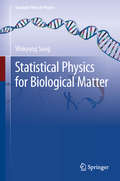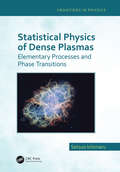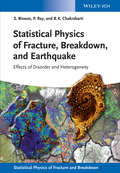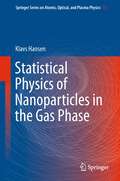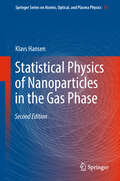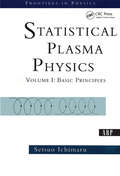- Table View
- List View
Statistical Methods in Molecular Biology
by Madhu Mazumdar Heather L. Epps Xi Kathy Zhou Heejung BangWhile there is a wide selection of 'by experts, for experts' books in statistics and molecular biology, there is a distinct need for a book that presents the basic principles of proper statistical analyses and progresses to more advanced statistical methods in response to rapidly developing technologies and methodologies in the field of molecular biology. Statistical Methods in Molecular Biology strives to fill that gap by covering basic and intermediate statistics that are useful for classical molecular biology settings and advanced statistical techniques that can be used to help solve problems commonly encountered in modern molecular biology studies, such as supervised and unsupervised learning, hidden Markov models, methods for manipulation and analysis of high-throughput microarray and proteomic data, and methods for the synthesis of the available evidences. This detailed volume offers molecular biologists a book in a progressive style where basic statistical methods are introduced and gradually elevated to an intermediate level, while providing statisticians knowledge of various biological data generated from the field of molecular biology, the types of questions of interest to molecular biologists, and the state-of-the-art statistical approaches to analyzing the data. As a volume in the highly successful Methods in Molecular BiologyTM series, this work provides the kind of meticulous descriptions and implementation advice for diverse topics that are crucial for getting optimal results. Comprehensive but convenient, Statistical Methods in Molecular Biology will aid students, scientists, and researchers along the pathway from beginning strategies to a deeper understanding of these vital systems of data analysis and interpretation within one concise volume.
Statistical Methods in Neuropsychology
by David Aaron MaroofThis book describes appropriate statistical models that are commonly utilized in neuropsychology. The book discusses such issues as developing normative data for neuropsychological measures, assessing the validity of neuropsychological tests, and quantifying change "over time" through longitudinal analyses. The rationale for and allure of the volume is the fact that there are no publications that dovetail the two subdisciplines of applied statistics and neuropsychology. The overall objective of this book is to provide a pragmatic and concrete source for applying methodological and statistical techniques in research studies whose emphasis includes neuropsychology. Since there are a plethora of technique to arrive at similar answers, each method with its strengths and weaknesses will be delineated. The beauty of the book will be that it will hopefully demystify commonly encountered issues faced with researchers. More specifically, it will provide a "how to do it" approach.
Statistical Methods in Radiation Physics
by James E. Turner Darryl J. Downing James S. BogardThis statistics textbook, with particular emphasis on radiation protection and dosimetry, deals with statistical solutions to problems inherent in health physics measurements and decision making. The authors begin with a description of our current understanding of the statistical nature of physical processes at the atomic level, including radioactive decay and interactions of radiation with matter. Examples are taken from problems encountered in health physics, and the material is presented such that health physicists and most other nuclear professionals will more readily understand the application of statistical principles in the familiar context of the examples. Problems are presented at the end of each chapter, with solutions to selected problems provided online. In addition, numerous worked examples are included throughout the text.
Statistical Modeling Using Bayesian Latent Gaussian Models: With Applications in Geophysics and Environmental Sciences
by Birgir HrafnkelssonThis book focuses on the statistical modeling of geophysical and environmental data using Bayesian latent Gaussian models. The structure of these models is described in a thorough introductory chapter, which explains how to construct prior densities for the model parameters, how to infer the parameters using Bayesian computation, and how to use the models to make predictions. The remaining six chapters focus on the application of Bayesian latent Gaussian models to real examples in glaciology, hydrology, engineering seismology, seismology, meteorology and climatology. These examples include: spatial predictions of surface mass balance; the estimation of Antarctica’s contribution to sea-level rise; the estimation of rating curves for the projection of water level to discharge; ground motion models for strong motion; spatial modeling of earthquake magnitudes; weather forecasting based on numerical model forecasts; and extreme value analysis of precipitation on a high-dimensional grid. The book is aimed at graduate students and experts in statistics, geophysics, environmental sciences, engineering, and related fields.
Statistical Modeling and Machine Learning for Molecular Biology (Chapman & Hall/CRC Computational Biology Series)
by Alan MosesMolecular biologists are performing increasingly large and complicated experiments, but often have little background in data analysis. The book is devoted to teaching the statistical and computational techniques molecular biologists need to analyze their data. It explains the big-picture concepts in data analysis using a wide variety of real-world molecular biological examples such as eQTLs, ortholog identification, motif finding, inference of population structure, protein fold prediction and many more. The book takes a pragmatic approach, focusing on techniques that are based on elegant mathematics yet are the simplest to explain to scientists with little background in computers and statistics.
Statistical Modeling for Biological Systems: In Memory of Andrei Yakovlev
by David Oakes Anthony Almudevar Jack HallThis book commemorates the scientific contributions of distinguished statistician, Andrei Yakovlev. It reflects upon Dr. Yakovlev’s many research interests including stochastic modeling and the analysis of micro-array data, and throughout the book it emphasizes applications of the theory in biology, medicine and public health. The contributions to this volume are divided into two parts. Part A consists of original research articles, which can be roughly grouped into four thematic areas: (i) branching processes, especially as models for cell kinetics, (ii) multiple testing issues as they arise in the analysis of biologic data, (iii) applications of mathematical models and of new inferential techniques in epidemiology, and (iv) contributions to statistical methodology, with an emphasis on the modeling and analysis of survival time data. Part B consists of methodological research reported as a short communication, ending with some personal reflections on research fields associated with Andrei and on his approach to science. The Appendix contains an abbreviated vitae and a list of Andrei’s publications, complete as far as we know. The contributions in this book are written by Dr. Yakovlev’s collaborators and notable statisticians including former presidents of the Institute of Mathematical Statistics and of the Statistics Section of the AAAS. Dr. Yakovlev’s research appeared in four books and almost 200 scientific papers, in mathematics, statistics, biomathematics and biology journals. Ultimately this book offers a tribute to Dr. Yakovlev’s work and recognizes the legacy of his contributions in the biostatistics community.
Statistical Modeling in Biomedical Research: Contemporary Topics and Voices in the Field (Emerging Topics in Statistics and Biostatistics)
by Ding-Geng Din Chen Yichuan ZhaoThis edited collection discusses the emerging topics in statistical modeling for biomedical research. Leading experts in the frontiers of biostatistics and biomedical research discuss the statistical procedures, useful methods, and their novel applications in biostatistics research. Interdisciplinary in scope, the volume as a whole reflects the latest advances in statistical modeling in biomedical research, identifies impactful new directions, and seeks to drive the field forward. It also fosters the interaction of scholars in the arena, offering great opportunities to stimulate further collaborations. This book will appeal to industry data scientists and statisticians, researchers, and graduate students in biostatistics and biomedical science. It covers topics in:Next generation sequence data analysisDeep learning, precision medicine, and their applicationsLarge scale data analysis and its applicationsBiomedical research and modelingSurvival analysis with complex data structure and its applications.
Statistical Modelling and Machine Learning Principles for Bioinformatics Techniques, Tools, and Applications (Algorithms for Intelligent Systems)
by K. G. Srinivasa G. M. Siddesh S. R. ManisekharThis book discusses topics related to bioinformatics, statistics, and machine learning, presenting the latest research in various areas of bioinformatics. It also highlights the role of computing and machine learning in knowledge extraction from biological data, and how this knowledge can be applied in fields such as drug design, health supplements, gene therapy, proteomics and agriculture.
Statistical Modelling and Risk Analysis: Selected contributions from ICRA9, Perugia, Italy, May 25-27, 2022 (Springer Proceedings in Mathematics & Statistics #430)
by Christos P. Kitsos Teresa A. Oliveira Francesca Pierri Marialuisa RestainoThis volume covers the latest results on novel methods in Risk Analysis and assessment, with applications in Biostatistics (which is providing food for thought since the first ICRAs, covering traditional areas of RA, until now), Engineering Reliability, the Environmental Sciences and Economics. The contributions, based on lectures given at the 9th International Conference on Risk Analysis (ICRA 9), at Perugia, Italy, May 2022, detail a wide variety of daily risks, building on ideas presented at previous ICRA conferences. Working within a strong theoretical framework, supporting applications, the material describes a modern extension of the traditional research of the 1980s. This book is intended for graduate students in Mathematics, Statistics, Biology, Toxicology, Medicine, Management, and Economics, as well as quantitative researchers in Risk Analysis.
Statistical Modelling in Biostatistics and Bioinformatics
by Gilbert Mackenzie Defen PengThis book presents selected papers on statistical model development related mainly to the fields of Biostatistics and Bioinformatics. The coverage of the material falls squarely into the following categories: (a) Survival analysis and multivariate survival analysis, (b) Time series and longitudinal data analysis, (c) Statistical model development and (d) Applied statistical modelling. Innovations in statistical modelling are presented throughout each of the four areas, with some intriguing new ideas on hierarchical generalized non-linear models and on frailty models with structural dispersion, just to mention two examples. The contributors include distinguished international statisticians such as Philip Hougaard, John Hinde, Il Do Ha, Roger Payne and Alessandra Durio, among others, as well as promising newcomers. Some of the contributions have come from researchers working in the BIO-SI research programme on Biostatistics and Bioinformatics, centred on the Universities of Limerick and Galway in Ireland and funded by the Science Foundation Ireland under its Mathematics Initiative.
Statistical Modelling of Occupant Behaviour
by Henrik Madsen Marcel Schweiker Jan Kloppenborg Møller Rune Korsholm Andersen Burak Gunay Selin Yilmaz Verena Marie BarthelmesDo you have data on occupant behaviour, indoor environment or energy use in buildings? Are you interested in statistical analysis and modelling? Do you have a specific (research) question and dataset and would like to know how to answer the question with the data available? Statistical Modelling of Occupant Behaviour covers a range of statistical methods and models used for modelling energy- and comfort-related occupant behaviour in buildings. It is a classical textbook on statistics, including many practical examples related to occupant behaviour that are either taken from real research problems or adapted from such. The main focus is traditional statistical techniques based on the likelihood principle that can be applied to occupant behaviour modelling, including: General, generalised linear and survival models Mixed effect and hierarchical models Linear time series and Markov models Linear state space and hidden Markov models Illustration of all methods using occupant behaviour examples implemented in R The built environment affects occupants who live and work in it, and occupants affect the built environment by adapting it to their needs – for example, by adapting their indoor environments by interacting with building components and systems. These adaptive behaviours account for great uncertainty in the prediction of building energy use and indoor environmental conditions. Occupant behaviour is complex and multi-disciplinary but can be successfully modelled using statistical approaches. Statistical Modelling of Occupant Behaviour is written for researchers and advanced practitioners who work with real-world applications and modelling of occupant data. It describes the kinds of statistical models that may be used in various occupant behaviour modelling research. It gives a theoretical overview of these methods and then applies them to the study of occupant behaviour using readily replaceable examples in the R environment that are based on actual and experimental data.
Statistical Models for Nuclear Decay: From Evaporation to Vaporization (Series in Fundamental and Applied Nuclear Physics)
by A.J ColeStatistical Models for Nuclear Decay: From Evaporation to Vaporization describes statistical models that are applied to the decay of atomic nuclei, emphasizing highly excited nuclei usually produced using heavy ion collisions. The first two chapters present essential introductions to statistical mechanics and nuclear physics, followed by a descript
Statistical Optics (Wiley Series in Pure and Applied Optics)
by Joseph W. GoodmanThis book discusses statistical methods that are useful for treating problems in modern optics, and the application of these methods to solving a variety of such problems This book covers a variety of statistical problems in optics, including both theory and applications. The text covers the necessary background in statistics, statistical properties of light waves of various types, the theory of partial coherence and its applications, imaging with partially coherent light, atmospheric degradations of images, and noise limitations in the detection of light. New topics have been introduced in the second edition, including: Analysis of the Vander Pol oscillator model of laser light Coverage on coherence tomography and coherence multiplexing of fiber sensors An expansion of the chapter on imaging with partially coherent light, including several new examples An expanded section on speckle and its properties New sections on the cross-spectrum and bispectrum techniques for obtaining images free from atmospheric distortions A new section on imaging through atmospheric turbulence using coherent light The addition of the effects of "read noise" to the discussions of limitations encountered in detecting very weak optical signals A number of new problems and many new references have been added Statistical Optics, Second Edition is written for researchers and engineering students interested in optics, physicists and chemists, as well as graduate level courses in a University Engineering or Physics Department.
Statistical Outliers and Related Topics
by Mir Masoom Ali Irfan Ali Haitham M. Yousof Rahmatullah ImonThe book is a collection of different aspects of outliers and related topics written by experts. Topics covered include definition of outliers, their sources, consequences, identification, computational and robustness issues, handling of outliers in diversified areas of statistics such as univariate and multivariate data, linear and generalized linear models, time series, linear functional and structural models, circular data, spatial data, big data, high dimensional data, multi-view data. The book emphasizes the importance of outliers, and will appeal to workers in Data Mining; which is one of the fastest-growing business applications of statistics. The book makes outlier detection methods widely usable by practitioners. Examples are drawn from various fields.
Statistical Physics
by Franz MandlThe Manchester Physics Series General Editors: D. J. Sandiford; F. Mandl; A. C. Phillips Department of Physics and Astronomy, University of Manchester Properties of Matter B. H. Flowers and E. Mendoza Optics Second Edition F. G. Smith and J. H. Thomson Statistical Physics Second Edition E. Mandl Electromagnetism Second Edition I. S. Grant and W. R. Phillips Statistics R. J. Barlow Solid State Physics Second Edition J. R. Hook and H. E. Hall Quantum Mechanics F. Mandl Particle Physics Second Edition B. R. Martin and G. Shaw The Physics of Stars Second Edition A. C. Phillips Computing for Scientists R. J. Barlow and A. R. Barnett Statistical Physics, Second Edition develops a unified treatment of statistical mechanics and thermodynamics, which emphasises the statistical nature of the laws of thermodynamics and the atomic nature of matter. Prominence is given to the Gibbs distribution, leading to a simple treatment of quantum statistics and of chemical reactions. Undergraduate students of physics and related sciences will find this a stimulating account of the basic physics and its applications. Only an elementary knowledge of kinetic theory and atomic physics, as well as the rudiments of quantum theory, are presupposed for an understanding of this book. Statistical Physics, Second Edition features:A fully integrated treatment of thermodynamics and statistical mechanics.A flow diagram allowing topics to be studied in different orders or omitted altogether.Optional "starred" and highlighted sections containing more advanced and specialised material for the more ambitious reader.Sets of problems at the end of each chapter to help student understanding. Hints for solving the problems are given in an Appendix.
Statistical Physics
by Ian FordThis undergraduate textbook provides a statistical mechanical foundation to the classical laws of thermodynamics via a comprehensive treatment of the basics of classical thermodynamics, equilibrium statistical mechanics, irreversible thermodynamics, and the statistical mechanics of non-equilibrium phenomena.This timely book has a unique focus on the concept of entropy, which is studied starting from the well-known ideal gas law, employing various thermodynamic processes, example systems and interpretations to expose its role in the second law of thermodynamics. This modern treatment of statistical physics includes studies of neutron stars, superconductivity and the recently developed fluctuation theorems. It also presents figures and problems in a clear and concise way, aiding the student's understanding.
Statistical Physics
by Y KlimontovichA look at Statistical Physics by renowned Russia-Soviet physicist Yuri Klimontovich of the Moscow State University, MSU Faculty of Physics.
Statistical Physics (Dover Books on Physics)
by Gregory H. WannierUntil recently, the field of statistical physics was traditionally taught as three separate subjects: thermodynamics, statistical mechanics, and kinetic theory. This text, a forerunner in its field and now a classic, was the first to recognize the outdated reasons for their separation and to combine the essentials of the three subjects into one unified presentation of thermal physics. It has been widely adopted in graduate and advanced undergraduate courses, and is recommended throughout the field as an indispensable aid to the independent study and research of statistical physics.Designed for a one-year course of instruction for non-specialist graduate students, or advanced undergraduates, the book is divided into three parts. Principles of Statistical Thermodynamics (Part I) covers the first and second laws of thermodynamics, elementary statistical methods in physics, and other topics, including an especially clear and enlightening discussion of thermodynamic potentials and their applications. Part II, devoted to equilibrium statistics of special systems, offers excellent coverage of the imperfect gas, lattice dynamics, the statistics of semiconductors, the two-dimension Ising model, and a particularly lucid chapter on dilute solutions. Moreover, the treatment of topics in solid state physics is more extensive than is usually found in books on statistical mechanics. Kinetic theory, transport coefficients, and fluctuations comprise Part III, with a fine presentation of the Kac ring model; the Boltzmann transport equation; kinetics of charge carriers in solids, liquids, and gases; fluctuations and Brownian motion, and more. A liberal quantity of problems has been added to each chapter, including a special section of "recommended problems," whose solutions will insure an adequate understanding of the text. Solutions of all problems will be found at the back of the book along with a list of supplementary literature.
Statistical Physics Of Dna: An Introduction to Melting, Unzipping and Flexibility of the Double Helix
by Nikos TheodorakopoulosThe stability of the DNA double helix is contingent on fine-tuning a number of physicochemical control parameters. Varying any one of them leads to separation of the two strands, in what constitutes a rare physical example of a thermodynamic phase transition in a one-dimensional system. The present book aims at providing a self-contained account of the statistical physics of cooperative processes in DNA, e.g. thermal and mechanical dissociation, force-induced melting, equilibria of hairpin-like secondary structures. In addition, the book presents some fundamental aspects of DNA elasticity, as observed in key experiments, old and new. The latter include some recently published scattering data on apparently soft, short DNA chains and their interpretation in terms of local structural defects (permanent bends, 'kinky DNA', after the original Crick-Klug hypothesis).The development of mathematical models used (Kratky-Porod polymer chain, Poland-Scheraga and Peyrard-Bishop-Dauxois models of DNA melting) emphasizes the use of realistic parameters and the relevance of practical numerical methods for comparing with experimental data. Accordingly, a large number of specially produced figures has been included.The presentation is at the level of an advanced undergraduate or introductory graduate course. An extra chapter provides the necessary mathematical background on elasticity of model polymer chains.
Statistical Physics for Biological Matter (Graduate Texts in Physics)
by Wokyung SungThis book aims to cover a broad range of topics in statistical physics, including statistical mechanics (equilibrium and non-equilibrium), soft matter and fluid physics, for applications to biological phenomena at both cellular and macromolecular levels. It is intended to be a graduate level textbook, but can also be addressed to the interested senior level undergraduate. The book is written also for those involved in research on biological systems or soft matter based on physics, particularly on statistical physics.Typical statistical physics courses cover ideal gases (classical and quantum) and interacting units of simple structures. In contrast, even simple biological fluids are solutions of macromolecules, the structures of which are very complex. The goal of this book to fill this wide gap by providing appropriate content as well as by explaining the theoretical method that typifies good modeling, namely, the method of coarse-grained descriptions that extract the most salient features emerging at mesoscopic scales. The major topics covered in this book include thermodynamics, equilibrium statistical mechanics, soft matter physics of polymers and membranes, non-equilibrium statistical physics covering stochastic processes, transport phenomena and hydrodynamics. Generic methods and theories are described with detailed derivations, followed by applications and examples in biology. The book aims to help the readers build, systematically and coherently through basic principles, their own understanding of nonspecific concepts and theoretical methods, which they may be able to apply to a broader class of biological problems.
Statistical Physics of Dense Plasmas: Elementary Processes and Phase Transitions (Frontiers in Physics)
by Setsuo IchimaruThis authoritative text offers a complete overview on the statistical mechanics and electrodynamics of physical processes in dense plasma systems. The author emphasizes laboratory-based experiments and astrophysical observations of plasma phenomena, elucidated through the fundamentals. The coverage encompasses relevant condensed matter physics, atomic physics, nuclear physics, and astrophysics, including such key topics as phase transitions, transport, optical and nuclear processes. This essential resource also addresses exciting, cutting edge topics in the field, including metallic hydrogen, stellar and planetary magnetisms, pycnonuclear reactions, and gravitational waves. <p><p> Scientists, researchers, and students in plasma physics, condensed matter physics, materials science, atomic physics, nuclear physics, and astrophysics will benefit from this work. <p> Setsuo Ichimaru is a distinguished professor at the University of Tokyo, and has been a visiting member at The Institute for Advanced Study in Princeton, New Jersey, at the University of California, San Diego (UCSD), the Institute for Theoretical Physics at Johannes Kepler University, and the Max Planck Institute for Quantum Optics. He is a recipient of the Subramanyan Chandrasekhar Prize of Plasma Physics from the Association of Asia-Pacific Physical Societies and the Humboldt Research Award from the Alexander von Humboldt Foundation.
Statistical Physics of Fracture, Beakdown, and Earthquake
by Bikas K. Chakrabarti Soumyajyoti Biswas Purusattam RayIn this book, the authors bring together basic ideas from fracture mechanics and statistical physics, classical theories, simulation and experimental results to make the statistical physics aspects of fracture more accessible. They explain fracture-like phenomena, highlighting the role of disorder and heterogeneity from a statistical physical viewpoint. The role of defects is discussed in brittle and ductile fracture, ductile to brittle transition, fracture dynamics, failure processes with tension as well as compression: experiments, failure of electrical networks, self-organized critical models of earthquake and their extensions to capture the physics of earthquake dynamics. The text also includes a discussion of dynamical transitions in fracture propagation in theory and experiments, as well as an outline of analytical results in fiber bundle model dynamics With its wide scope, in addition to the statistical physics community, the material here is equally accessible to engineers, earth scientists, mechanical engineers, and material scientists. It also serves as a textbook for graduate students and researchers in physics.
Statistical Physics of Nanoparticles in the Gas Phase
by Klavs HansenThermal processes are ubiquitous and an understanding of thermal phenomena is essential for a complete description of the physics of nanoparticles, both for the purpose of modeling the dynamics of the particles and for the correct interpretation of experimental data. This book has the twofold aim to present coherently the relevant results coming from the recent scientific literature and to guide the readers through the process of deriving results, enabling them to explore the limits of the mathematical approximations and test the power of the method. The book is focused on the fundamental properties of nanosystems in the gas phase. For this reason there is a strong emphasis on microcanonical physics. Each chapter is enriched with exercises and 3 Appendices provide additional useful materials.
Statistical Physics of Nanoparticles in the Gas Phase (Springer Series on Atomic, Optical, and Plasma Physics #73)
by Klavs HansenThermal processes are ubiquitous and an understanding of thermal phenomena is essential for a complete description of the physics of nanoparticles, both for the purpose of modeling the dynamics of the particles and for the correct interpretation of experimental data.The second edition of this book follows the logic of first edition, with an emphasis on presentation of literature results and to guide the reader through derivations. Several topics have been added to the repertoire, notably magnetism, a fuller exposition of aggregation and the related area of nucleation theory. Also a new chapter has been added on the transient hot electron phenomenon. The book remains focused on the fundamental properties of nanosystems in the gas phase. Each chapter is enriched with additional new exercises and three Appendices provide additional useful material.
Statistical Plasma Physics, Volume I: Basic Principles (Frontiers in Physics #1)
by Setsuo IchimaruPlasma physics is an integral part of statistical physics, complete with its own basic theories. Designed as a two-volume set, Statistical Plasma Physics is intended for advanced undergraduate and beginning graduate courses on plasma and statistical physics, and as such, its presentation is self-contained and should be read without difficulty by those with backgrounds in classical mechanics, electricity and magnetism, quantum mechanics, and statistics. Major topics include: plasma phenomena in nature, kinetic equations, plasmas and dielectric media, electromagnetic properties of Vlasov plasmas in thermodynamic equilibria, transient processes, and instabilities. Statistical Plasma Physics, Volume II, treats subjects in the field of condensed plasma physics, with applications to condensed matter physics, atomic physics, nuclear physics, and astrophysics.
